Technical diagram templates
Effortlessly build diagrams and systems with Miro's technical diagram templates and examples. Whether you're mapping out software architecture, network infrastructure, or any other technical setup, our templates offer a clear and structured approach to ensure precision and clarity. Enhanced by real-world examples from our active community, these templates provide a robust framework for accurate planning and effective communication throughout your technical projects.
40 templates
Use Case Diagram Template
1 likes844 uses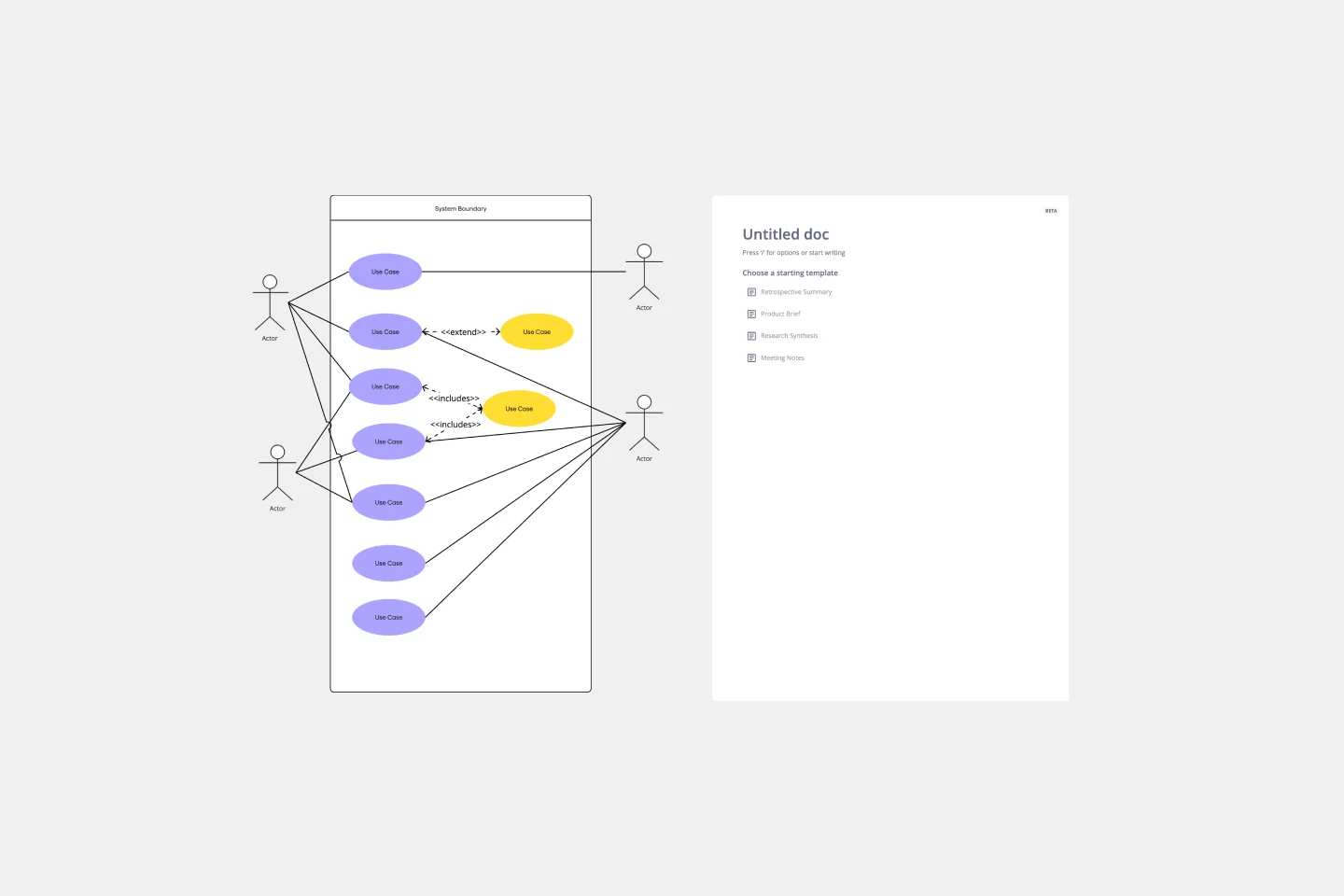
Use Case Diagram Template
A use case diagram is a visual tool that helps you analyze the relationships between personas and use cases. Use case diagrams typically depict the expected behavior of the system: what will happen and when. A use case diagram is helpful because it allows you to design a system from the perspective of the end user. It’s a valuable tool for communicating your desired system behavior in the language of the user, by specifying all externally visible system behavior.
Data Flow Diagram Template
4 likes576 uses
Data Flow Diagram Template
Any process can get pretty complex, especially when it has multiple components. Get a better grasp of your process through a data flow diagram (DFD). DFDs create a simple visual representation of all components in the flow of data and requirements in an entire system. They’re most often used by growth teams, data analysts, and product teams, and they’re created with one of three levels of complexity—0, 1, or 2. This template will help you easily build the best DFD for your process.
Context Diagram Template
2 likes395 uses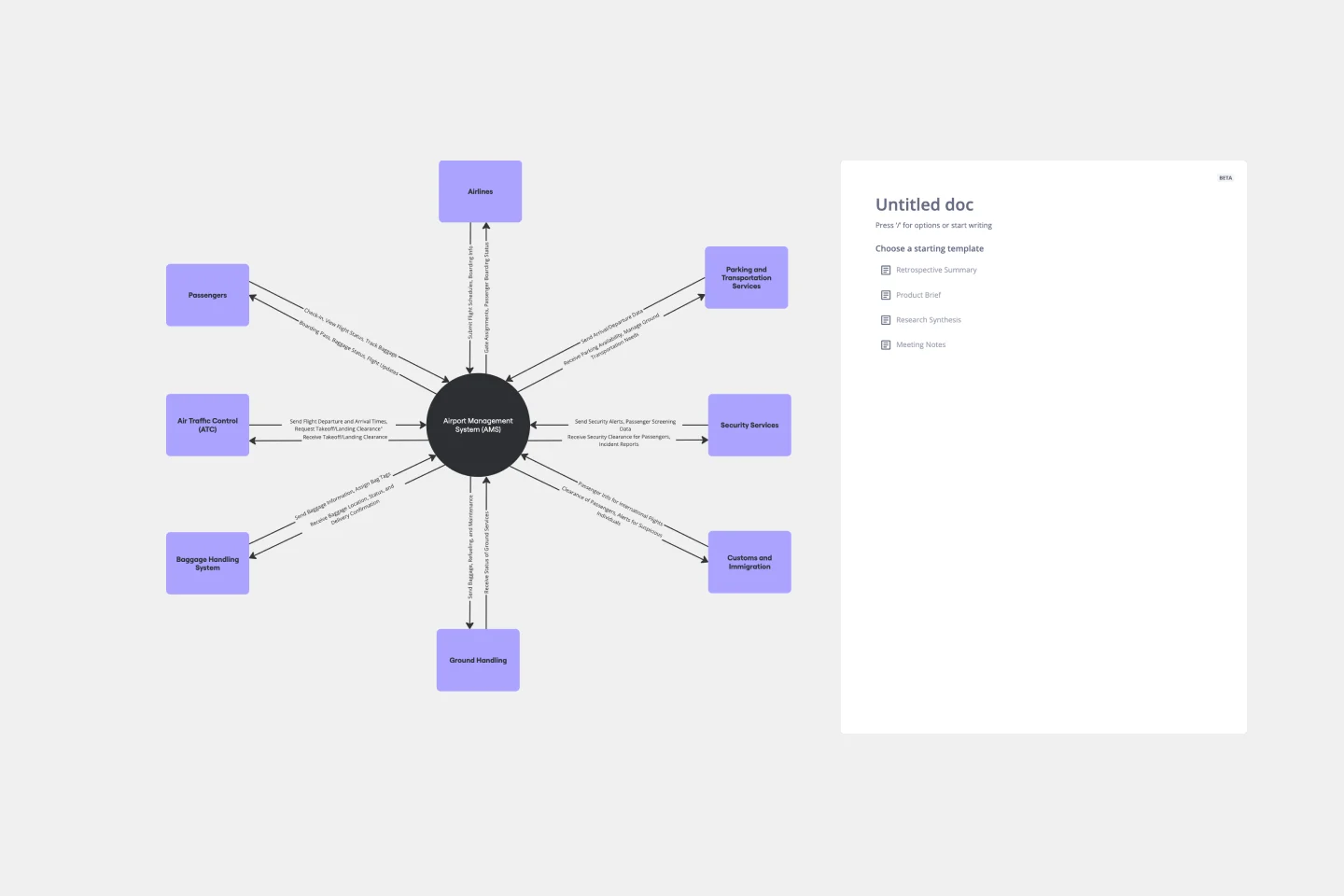
Context Diagram Template
A context diagram is a perfect tool to view an entire system as a single process and understand how external factors interact with it. These external factors can include customers, developers, management, and more. The Context Diagram Template is your tool for creating this diagram.
UML Activity Diagram Template
0 likes304 uses
UML Activity Diagram Template
Use our Activity Diagram template to break down activities into smaller decisions and subprocesses. Improve and optimize systems and processes in I.T., business management, and more.
Google Cloud Architecture Diagram Template
2 likes276 uses
Google Cloud Architecture Diagram Template
Use the Google Cloud Architecture Diagram template to clearly visualize the deployment of your application and allow you and your team to optimize processes. The GCP template gives you a great overview of your application architecture, and it helps you to iterate quickly and better manage your application development, deployment, and documentation. Try it out and see if it works for you.
UML Class Diagram Template
0 likes246 uses
UML Class Diagram Template
Get a template for quickly building UML class diagrams in a collaborative environment. Use the UML class diagram template to design and refine conceptual systems, then let the same diagram guide your engineers as they write the code.
UML Diagram Template
5 likes225 uses
UML Diagram Template
Originally used as a modeling language in software engineering, UML has become a popular approach to application structures and documenting software. UML stands for Unified Modeling Language, and you can use it to model business processes and workflows. Like flowcharts, UML diagrams can provide your organization with a standardized method of mapping out step-by-step processes. They allow your team to easily view the relationships between systems and tasks. UML diagrams are an effective tool that can help you bring new employees up to speed, create documentation, organize your workplace and team, and streamline your projects.
UML Component Diagram Template
0 likes193 uses
UML Component Diagram Template
Use our Component Diagram template to show how a system’s physical components are organized and wired together. Visualize implementation details, make sure planned development matches system needs, and more — all in a collaborative environment.
UML Sequence Deployment Pipeline Template
0 likes177 uses
UML Sequence Deployment Pipeline Template
The UML Sequence Deployment Pipeline Template in Miro visually maps the sequence of steps in an automated deployment pipeline, helping teams in software development and deployment. It helps identify bottlenecks, standardizes the deployment process, and facilitates new member onboarding for continuous improvement.
Logic Model Template
1 likes176 uses
Logic Model Template
The logic model template is a strategic visual tool designed to delineate the relationship between a program's inputs, activities, outputs, and outcomes. By providing a clear and comprehensive map of the project lifecycle, stakeholders can swiftly grasp the intricate connections within a given initiative. One standout benefit of this template is its ability to enhance clarity: by visually representing the transformation of resources into anticipated results, teams can ensure more efficient and targeted use of their resources, thus maximizing the potential for success in their endeavors.
Challenge - UML Iphone
5 likes171 uses
Challenge - UML Iphone
The Challenge UML Iphone template offers a visual framework for designing and modeling iPhone app challenges and solutions using UML (Unified Modeling Language). It provides elements for defining app functionalities, user interactions, and system architecture. This template enables teams to brainstorm ideas, document requirements, and visualize app designs, facilitating collaboration and innovation. By promoting clarity and alignment, the Challenge - UML Iphone template empowers teams to design iPhone apps that meet user needs and deliver exceptional user experiences.
Block Diagram Template
1 likes150 uses
Block Diagram Template
Use this template to illustrate technical systems. Blocks represent important objects in the system, and arrows demonstrate how the objects relate to each other. Perfect for engineers, workflow managers, or anyone trying to build a better process.
Azure Data Flow Template
2 likes116 uses
Azure Data Flow Template
The Azure Data Flow is a diagram that will allow you to combine data and build and deploy custom machine learning models at scale. Azure is Microsoft’s cloud computing platform, designed to provide many cloud-based services like remote storage, database hosting, and centralized account management. Azure also offers new capabilities like AI and the Internet of Things (IoT).
UML State Machine Diagram Template
2 likes103 uses
UML State Machine Diagram Template
Visualize the workflow of a process and how objects perform actions based on different stimuli. State machine diagrams are valuable for understanding how an object responds to events at the different stages of its life cycle. They are also helpful for visualizing event sequences in a system.
Incident Management Process Flowchart Template
4 likes102 uses
Incident Management Process Flowchart Template
The Incident Management Process Flowchart Template in Miro is designed to streamline and clarify the process of managing incidents within an organization. This template serves as a visual guide that outlines the steps involved in incident management, from the initial declaration to the final review. It is a living document, continuously evolving based on feedback and lessons learned from past incidents, ensuring that the process remains up-to-date with best practices. By defining incidents as disruptions requiring a coordinated response to restore service levels, the template emphasizes the importance of a structured, organized, and timely approach. It covers various phases such as Incident Declaration, Assessment, Response, Communication, and Review, providing a clear framework for teams to follow.
Kubernetes Architecture Diagram Template
3 likes98 uses
Kubernetes Architecture Diagram Template
Use the Kubernetes Architecture Diagram template to manage your containerized applications better and bring your apps’ deployment, management, and scalability to the next level. This template helps you lower the downtime in production and allows you to have a more agile app production. Improve the deployment of your apps by visualizing every step of the process with the Kubernetes Architecture template. Try it out, and see if it works for you and your team.
UML Use Case Online Shopping System Template
0 likes80 uses
UML Use Case Online Shopping System Template
The Online Shopping System Template simplifies the process of documenting and visualizing how users interact with an online shopping system. It provides a standard way to map out user interactions, such as product listings, inventory management, shopping carts, order processing, payments, and shipping details. By using this template, teams can collaborate effectively in real-time or at different times, adjusting the diagram to meet their project's specific needs. This not only improves clarity and efficiency but also fosters better communication among team members and stakeholders, ensuring a thorough understanding of the system's design and requirements.
ERD Healthcare Management System Template
1 likes62 uses
ERD Healthcare Management System Template
The ERD Healthcare Management System Template streamlines the process of creating and managing entity-relationship diagrams for healthcare management systems. This template helps users visualize the complex relationships between different entities such as patients, healthcare providers, medical records, and billing information. It offers a flexible and customizable framework that can be adapted to fit the specific needs of any healthcare management system, ensuring clarity and efficiency in system design and database structure.
API Development Template
3 likes62 uses
API Development Template
Scattered API documentation living in different tools while your endpoints multiply faster than you can document them? This visual API development template brings structure to the chaos. Map your complete API workflow from initial planning through deployment, identify potential issues early, and create documentation that actually stays current. Perfect for engineering teams who want to ship better APIs without the usual documentation headaches. Use this template to create comprehensive API plans using Miro's advanced Diagrams format.
On-Premise to Cloud Migration Process Flowchart Template
2 likes61 uses
On-Premise to Cloud Migration Process Flowchart Template
The On-Premise to Cloud Migration Process Flowchart Template is a strategic tool designed to streamline the transition from traditional on-premise systems to more flexible, scalable cloud-based solutions. This template acts as a visual roadmap, guiding teams through each phase of the migration process with clarity and precision. By breaking down the migration into manageable steps, it ensures a comprehensive approach, minimizing risks and aligning with best practices for cloud adoption.
Cisco Recommended Security Architecture Template
1 likes55 uses
Cisco Recommended Security Architecture Template
Cisco offers data center and access networking solutions built for scale with industry-leading automation, programmability, and real-time visibility. The Cisco Recommended Security Architecture uses Cisco elements to visually show the network design of Cisco networks.
UML Sequence Registration Process Template
3 likes54 uses
UML Sequence Registration Process Template
The UML Sequence Registration Process Template helps visualize and document user registration processes. It enables the rapid creation of sequence diagrams, which are crucial for enhancing clarity and identifying potential issues early in the design phase. This template not only supports collaborative efforts through Miro's platform, facilitating real-time teamwork, but also ensures a comprehensive system design. Being part of a broader collection of UML diagram templates, it stands as a valuable asset for projects involving registration workflows, contributing to streamlined project execution and effective communication among team members.
UML Sequence Rental Booking System Template
1 likes53 uses
UML Sequence Rental Booking System Template
The UML Sequence Rental Booking System Template streamlines the process of documenting and visualizing the interactions within a car rental booking system. This template maps out the communication flow between the customer, user interface, payment service, and vehicle allocation system, ensuring a smooth and efficient workflow. By providing a clear visual representation of these interactions, the template helps in improving understanding among team members and stakeholders, promoting efficient design and collaboration.
UML Communication Diagram Template
1 likes52 uses
UML Communication Diagram Template
Most modern programs consist of many moving parts working to a precise set of instructions. With a communication diagram, you can visualize exactly how those parts work together, giving you a clearer understanding of your program as a whole. What’s more, the diagram leaves spaces for expanding the network of relationships as your product grows and evolves. A communication diagram is a vital tool in any software designer’s arsenal.
Product Development Process Flowchart Template
1 likes49 uses
Product Development Process Flowchart Template
The Product Development Process Flowchart Template is a strategic tool designed to guide teams through the intricate journey of bringing a new product to market. This template serves as a visual roadmap, outlining each critical step in the product development lifecycle, from initial concept and design to testing, refinement, and eventual launch. It's structured to foster clarity, ensuring that all team members are aligned and aware of their roles and responsibilities at every phase.
Login Sequence Diagram Template
1 likes44 uses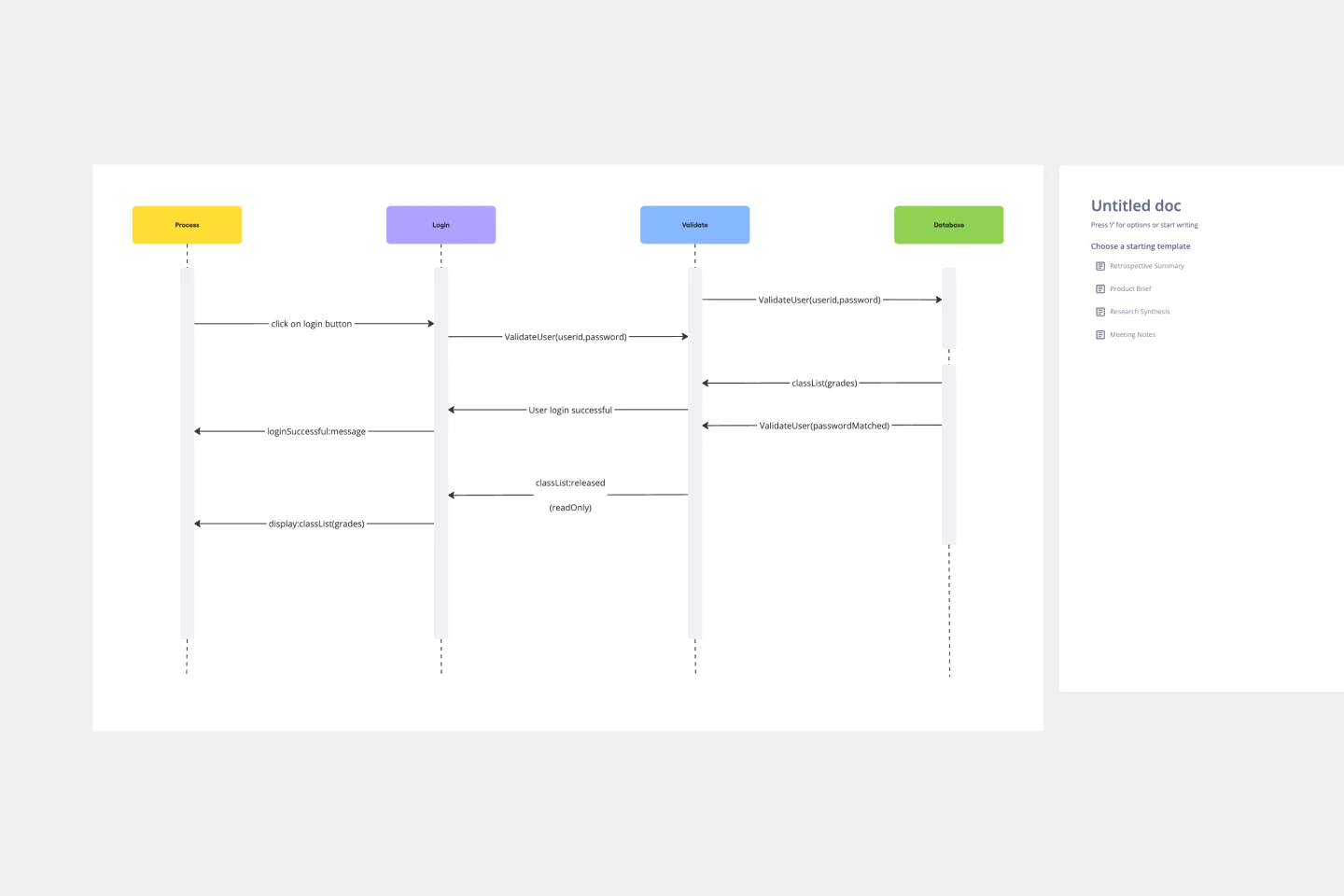
Login Sequence Diagram Template
The UML Sequence Login Diagram Template is a valuable tool for visualizing user authentication processes. It breaks down complex login sequences into clear, visual components, facilitating collaborative understanding among team members, regardless of their technical expertise. This shared understanding is crucial for ensuring all stakeholders, from developers to project managers, are on the same page, leading to efficient decision-making and a smoother development process. The template's ability to translate technical details into an accessible format streamlines communication and significantly reduces the likelihood of misinterpretation or oversight, making it an essential asset in any software development project.
ERD Blogging System Template
0 likes37 uses
ERD Blogging System Template
The ERD Blogging System template in Miro efficiently manages and organizes digital content. It features key entities such as User, Post, Comment, Category, Tag, and File, which are essential for managing the creation and publication of blog posts, engaging users through comments, and organizing content via categories and tags. Additionally, it supports media attachments through the File entity, linking them to the relevant content. This template helps streamline the blogging process, making it an invaluable tool for content management and publication.
ERD Educational Learning Management System Template
1 likes32 uses
ERD Educational Learning Management System Template
The ERD Educational Learning Management System Template is designed to streamline the management and organization of educational systems, particularly useful for institutions adapting to online and hybrid learning environments. It helps in efficiently planning and implementing Learning Management System (LMS) features by identifying key entities such as Students, Courses, Instructors, Assignments, and Grades, and the relationships between them.
ERD Customer Relationship Management (CRM) Template
2 likes31 uses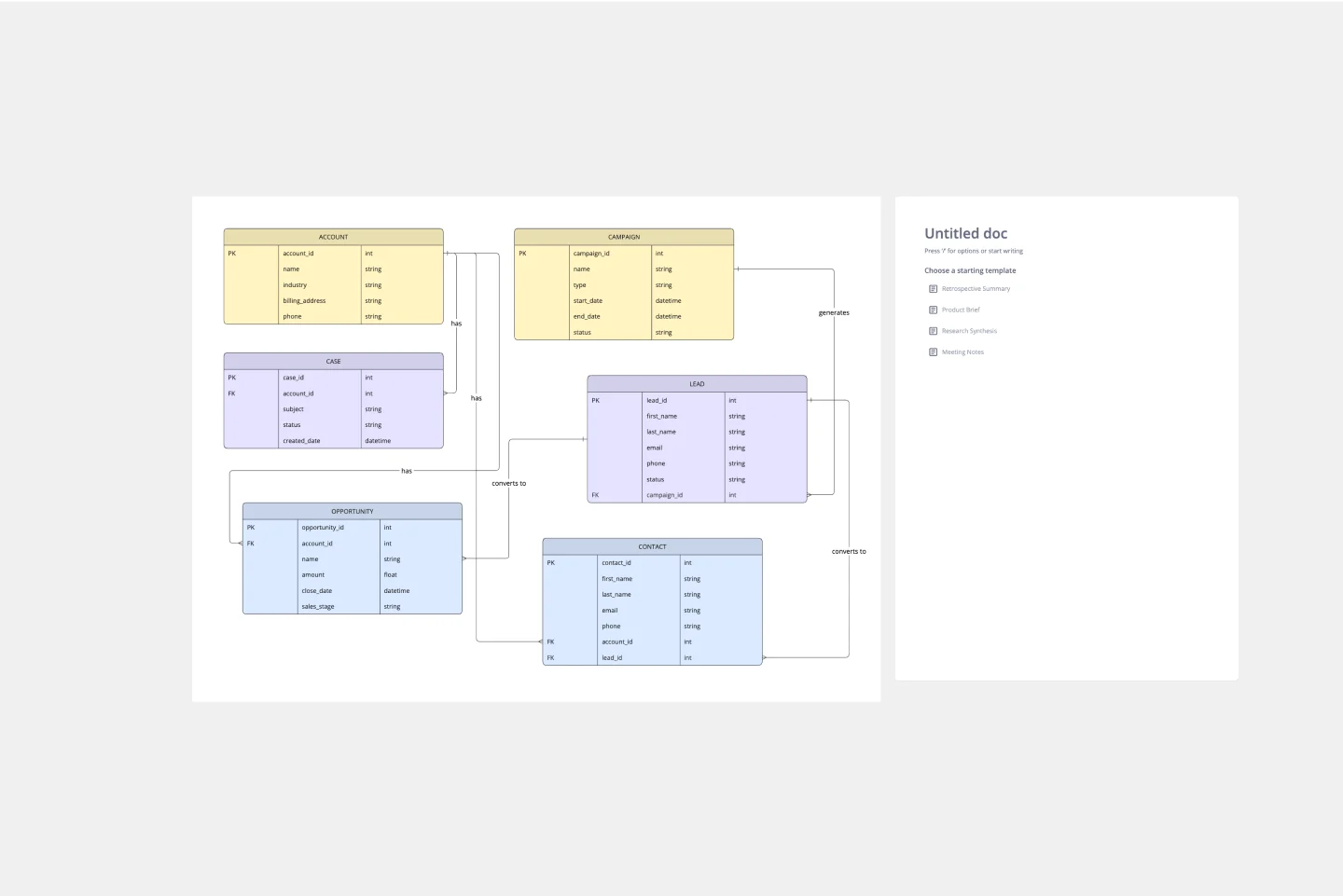
ERD Customer Relationship Management (CRM) Template
The ERD Customer Relationship Management (CRM) template streamlines and enhances the management of customer relationships within businesses. It focuses on organizing customer information and interactions in a visually intuitive manner. Key entities such as Customer, Interaction, Sales Opportunity, Product, and Support Ticket are central to the template, facilitating the tracking of customer relationships, sales funnel activities, product purchases, and customer service interactions. This structured approach is critical for boosting customer satisfaction and optimizing sales strategies, making the ERD CRM template an invaluable asset for businesses aiming to improve their CRM processes.

Entity–Relationship Diagram (ERD) HR Management System Template
The Entity–Relationship Diagram (ERD) HR Management System Template in Miro is designed to streamline the management of employee-related information and processes within an organization. This template allows for the visualization and organization of complex HR systems, making it easier to understand relationships and processes. It enables users to map out departments, positions, and employee details, including attendance records, payroll, and performance reviews.
Business Intelligence Architecture Template
2 likes25 uses
Business Intelligence Architecture Template
The Business Intelligence Architecture Diagram Template in Miro visually maps the complex landscape of business intelligence systems. With elements encompassing data sources, warehouses, ETL processes, tools, and end-user interfaces, the template enables users to communicate complex concepts with clarity. One standout feature is the template's dynamic adaptability, empowered by Miro's automated diagramming capabilities. This feature ensures that the diagram remains up-to-date with minimal effort, allowing users to effortlessly incorporate changes in data structures and processes, thus maintaining the relevance and accuracy of their visual representations over time.
UML Class E-Commerce System Template
2 likes22 uses
UML Class E-Commerce System Template
The UML Class E-Commerce System Template streamlines the process of creating and visualizing the class structure of an e-commerce system. It provides a comprehensive framework that includes typical online shop features such as product listings, inventory management, shopping carts, orders, payments, and shipping details. This template facilitates a clear understanding of how these elements interact during an online sales transaction, making it an invaluable tool for teams working on e-commerce projects. By using this template, teams can save time, enhance collaboration, and ensure that their system architecture is robust and efficient, ready to adapt to their business's evolving needs.
AWS Chef Automate Architecture Template
1 likes21 uses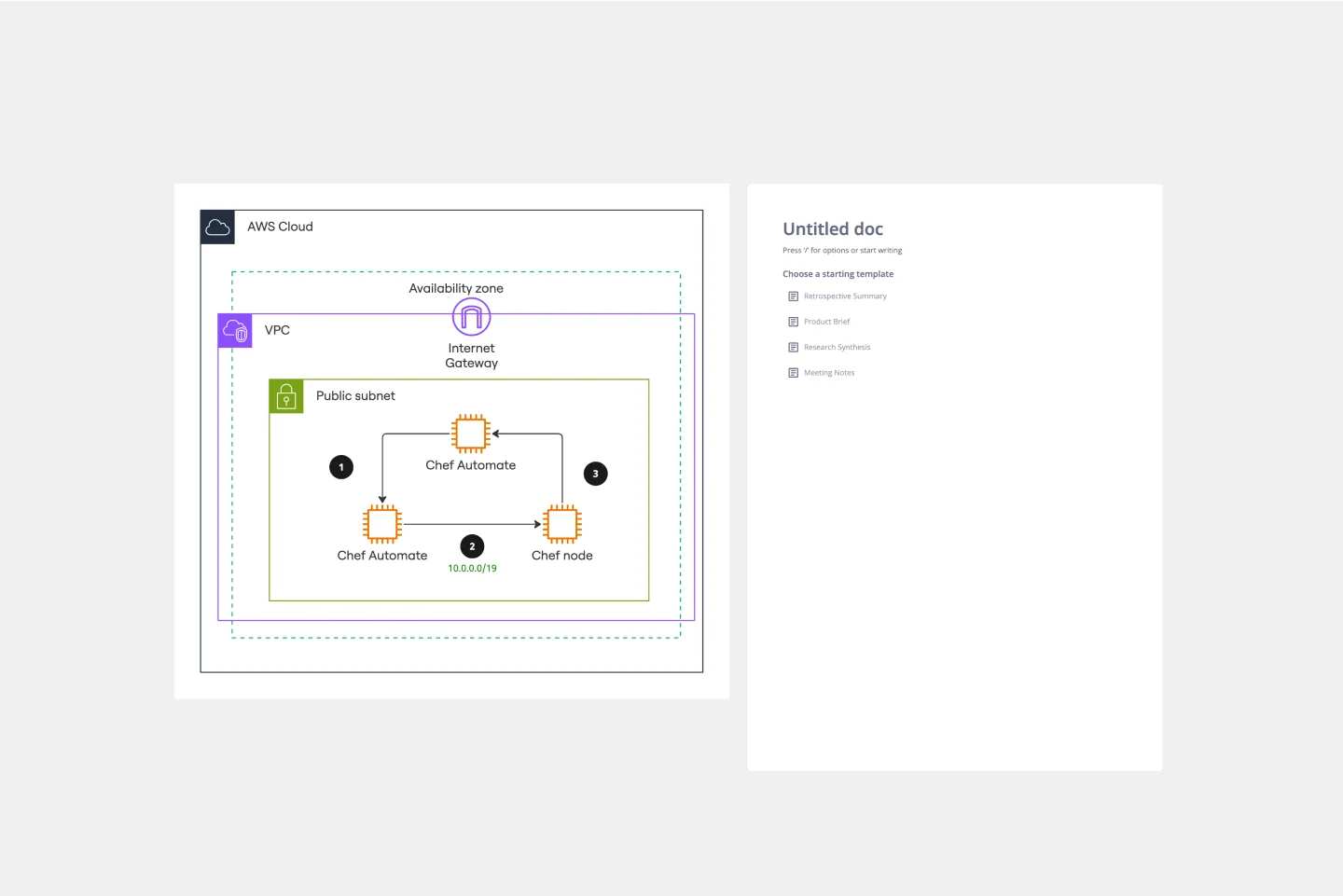
AWS Chef Automate Architecture Template
The AWS Chef Automate Architecture Template is a visual representation of the AWS Chef framework. Track your cloud solutions easily, and automate operational tasks at scale like never before.
UML Sequence E-commerce Checkout Template
1 likes19 uses
UML Sequence E-commerce Checkout Template
The UML Sequence E-commerce Checkout Template in Miro is a versatile tool for visualizing and analyzing e-commerce checkout processes. It provides a step-by-step visual representation of system interactions, is highly customizable, supports real-time collaboration, and is suitable for various e-commerce platforms. It serves as an efficient documentation tool, fosters team collaboration, and contributes to a more streamlined checkout experience for customers.
AWS Git to S3 Webhooks Template
0 likes19 uses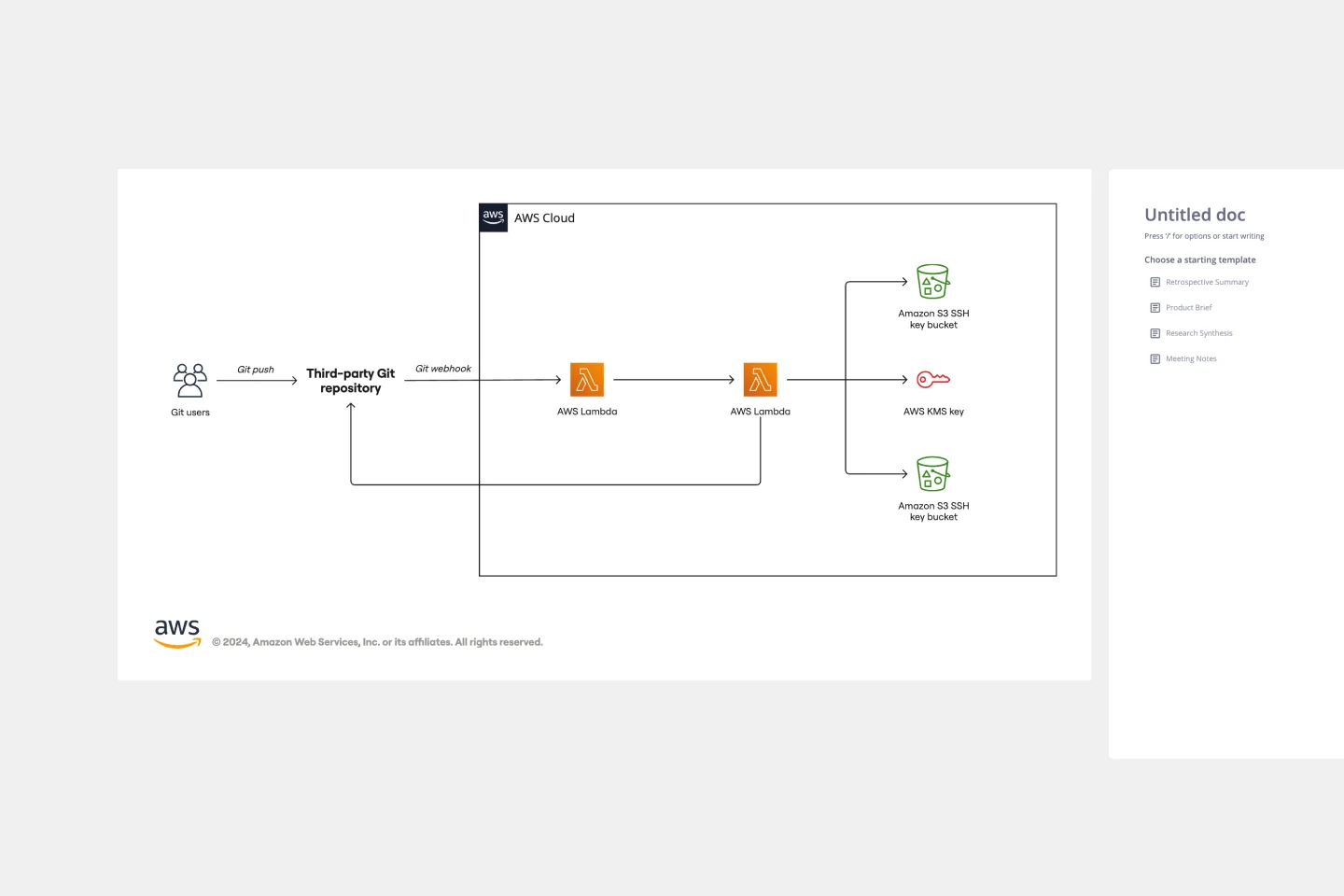
AWS Git to S3 Webhooks Template
The AWS Git to S3 Webhooks Template is a visual representation of Git webhooks with AWS services Quick Start architecture. You can now have an overview of your AWS architecture with Miro’s AWS Git to S3 Webhooks Template, track your cloud solutions easily, and optimize processes like never before.
Azure Demand Forecasting Template
1 likes17 uses
Azure Demand Forecasting Template
The Azure Demand Forecasting diagram will show the architecture of a demand forecast, making it easier for you to predict data consumption, costs, and forecast results. Azure is Microsoft’s cloud computing platform, designed to provide cloud-based services such as remote storage, database hosting, and centralized account management. Azure also offers new capabilities like AI and the Internet of Things (IoT).

Explore more
Explore Miro's Technical Diagram Templates
Discover the power of Miro's technical diagram templates, crafted to simplify complex systems and processes. Infused with insights from our vibrant community, these technical diagram examples are your go-to resource for precise planning and effective communication.
Why you’ll love our technical diagram examples
Our technical diagramming templates are carefully selected to help you understand how to represent complex systems. Whether you need to document a supply chain management system or create a sequence for an automated deployment pipeline, our examples provide a blueprint for your diagramming needs. Here are some of the benefits of using our technical diagramming templates:
Intuitive and accessible: Designed for ease of use.
Facilitates collaboration: Real time teamwork in a single workspace, powered by AI.
Customizable: Adaptable examples for documenting processes, designing systems, or planning projects.
Efficiency: Users report a 20% reduction in time for diagramming tasks when using Miro technical diagramming templates.
Inspiration and innovation: Encourages creative problem-solving and effective communication.
Significant impact: Streamlines design processes, leading to faster product and service development.
How to use your technical diagram template in Miro
Here's how to create your technical diagram template with Miro:
Select the right template: Browse our collection and choose a template that fits your technical requirements.
Customize it: Tailor the template to reflect your project's unique details. Define components, connections, and key specifications.
Engage your team: Invite your team to collaborate. Miro fosters inclusive teamwork, allowing every voice to be heard.
Draft and adapt: Use our advanced diagramming tools to help you outline your technical setup. Easily adjust components and connections with drag-and-drop simplicity as project needs evolve.
Incorporate feedback: Encourage an open dialogue. Refine your diagram by integrating input from your team.
Track progress: Review your diagram regularly to monitor the development of your project. Update as necessary to stay on track.
Share updates: Keep stakeholders informed about progress and changes using the diagram as a communication tool.
By embracing these steps, you'll effectively use Miro's technical diagram templates, ensuring your team remains accurate and aligned as your project unfolds.